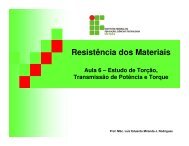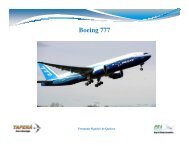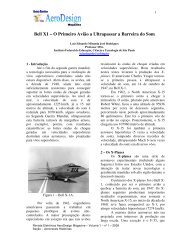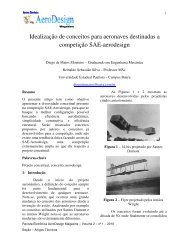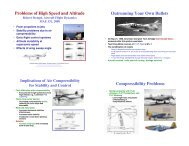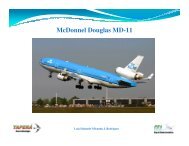The Anatomy of an ER-2 Aircraft - Site Equipe Taperá
The Anatomy of an ER-2 Aircraft - Site Equipe Taperá
The Anatomy of an ER-2 Aircraft - Site Equipe Taperá
You also want an ePaper? Increase the reach of your titles
YUMPU automatically turns print PDFs into web optimized ePapers that Google loves.
<strong>The</strong> <strong>Anatomy</strong> <strong>of</strong> <strong>an</strong><br />
<strong>ER</strong>-2 <strong>Aircraft</strong><br />
•Instrumentation<br />
•Observation<br />
•Experimentation<br />
By Cerese Albers
<strong>The</strong> <strong>ER</strong>-2 helps with the TCSP<br />
missions objectives:<br />
TCSP research will address the following<br />
topical areas:<br />
1) tropical cyclone structure, genesis, intensity<br />
ch<strong>an</strong>ge, moisture fields <strong>an</strong>d rainfall;<br />
2) satellite <strong>an</strong>d aircraft remote sensor data<br />
assimilation <strong>an</strong>d validation studies pertaining to<br />
development <strong>of</strong> tropical cyclones; <strong>an</strong>d<br />
3) the role <strong>of</strong> upper tropospheric/lower<br />
stratospheric processes governing tropical<br />
cyclone outflow, the response <strong>of</strong> wave<br />
disturb<strong>an</strong>ces to deep convection <strong>an</strong>d the<br />
evolution <strong>of</strong> the upper level warm core.
<strong>The</strong> <strong>ER</strong>-2<br />
typically<br />
operates at<br />
altitudes above<br />
65,000 feet,<br />
above 95<br />
percent <strong>of</strong> the<br />
earth's<br />
atmosphere,<br />
allowing the<br />
aircraft to use<br />
m<strong>an</strong>y <strong>of</strong> the<br />
same sensors<br />
similar to those<br />
used by<br />
orbiting<br />
satellites.<br />
Two <strong>ER</strong>-2s fly over <strong>The</strong> Golden Gate Bridge, S<strong>an</strong> Fr<strong>an</strong>cisco CA<br />
<strong>The</strong> <strong>ER</strong>-2 High Altitude Research <strong>Aircraft</strong> carries a<br />
single pilot <strong>an</strong>d up to 2600 pounds <strong>of</strong> payload to<br />
altitudes approaching 70,000 feet. It is a modified<br />
version <strong>of</strong> the U-2 aerial reconnaiss<strong>an</strong>ce airpl<strong>an</strong>e.
A typical mission lasts up to six-<strong>an</strong>d-one-half hours <strong>an</strong>d covers 2,200 nautical<br />
miles. Under certain conditions, it is possible to extend this to eight hours <strong>an</strong>d<br />
3,000 nautical miles. <strong>The</strong> maximum-altitude mission pr<strong>of</strong>ile involves a steady<br />
climb from 60,000 feet to 70,000 at a const<strong>an</strong>t mach number.<br />
View out the window <strong>of</strong> the <strong>ER</strong>-2 near max altitude
<strong>The</strong> <strong>ER</strong>-2 is equipped with <strong>an</strong> Inertial Navigation System that c<strong>an</strong><br />
get position updates from <strong>an</strong> on-board GPS receiver. It also has a<br />
data recording <strong>an</strong>d distribution system that records aircraft<br />
perform<strong>an</strong>ce <strong>an</strong>d navigation data <strong>an</strong>d distributes it to each <strong>of</strong> the<br />
payload areas. <strong>The</strong> <strong>ER</strong>-2 core instruments include:<br />
•Daedalus multi-spectral sc<strong>an</strong>ners with the following<br />
configurations:<br />
•<strong>The</strong>matic Mapper Simulator<br />
•Multi-spectral Airborne Mapping System<br />
•Airborne Oce<strong>an</strong> Color Imager<br />
•MODIS Airborne Simulator<br />
•Three types <strong>of</strong> aerial cameras that provide high-resolution<br />
photography at several scales <strong>an</strong>d resolutions<br />
•A video imaging system.
<strong>Anatomy</strong> <strong>of</strong> the <strong>ER</strong>-2 <strong>Aircraft</strong><br />
Named parts <strong>of</strong> the pl<strong>an</strong>e
<strong>The</strong> <strong>ER</strong>-2 is equipped with UHF, VHF, <strong>an</strong>d HF radio<br />
systems for two-way voice communication. An Air Traffic<br />
Control (ATC) tr<strong>an</strong>sponder enables surveill<strong>an</strong>ce radar to<br />
identify the aircraft via coded tr<strong>an</strong>smissions.<br />
<strong>The</strong> <strong>ER</strong>-2 c<strong>an</strong> navigate with respect to ground based<br />
radio beacons, as selected by the pilot. Navigation aids<br />
used for this include: low-frequency Automatic Direction<br />
Finding (ADF), Tactical Air Navigation (TACAN) for<br />
bearing <strong>an</strong>d r<strong>an</strong>ge information, <strong>an</strong>d a VHF<br />
Omnidirectional R<strong>an</strong>ge/Instrument L<strong>an</strong>ding System<br />
(VOR/ILS).<br />
Inertial Navigation Systems<br />
<strong>The</strong> Inertial Navigation System (INS) on the <strong>ER</strong>-2<br />
operates by sensing accelerations from a gyro-stabilized,<br />
all-attitude platform. This information is integrated by a<br />
digital computer to provide <strong>an</strong> indication <strong>of</strong> present<br />
position (latitude <strong>an</strong>d longitude), attitude data (pitch <strong>an</strong>d<br />
roll), <strong>an</strong>d course line computation referenced to great<br />
circle routes. A control display unit in the cockpit allows<br />
the pilot to store navigation way points <strong>an</strong>d to ch<strong>an</strong>ge the<br />
flight track enroute. A self-contained system, the INS<br />
<strong>of</strong>fers world-wide navigation capability.<br />
An update function allows for GPS updating <strong>of</strong> the INS to<br />
provide navigation independent <strong>of</strong> the drift errors.
<strong>Anatomy</strong> <strong>of</strong> the <strong>ER</strong>-2 <strong>Aircraft</strong>
Instruments onboard the TCSP<br />
<strong>ER</strong>-2 <strong>Aircraft</strong><br />
• Adv<strong>an</strong>ced Microwave Precipitation Radiometer (AMPR)<br />
• Cloud Radar System (CRS)<br />
• <strong>ER</strong>-2 Doppler Radar (EDOP)<br />
• High Altitude MMIC Sounding Radiometer (HAMSR)<br />
• Lightning Instrument Package (LIP-<strong>ER</strong>-2)<br />
• Microwave Temperature Pr<strong>of</strong>iler (MTP -<strong>ER</strong>-2)<br />
• MODIS Airborne Simulator (MAS)<br />
• Research Environment for Vehicle-Embedded Analysis on<br />
Linux (REVEAL)
INTRODUCTION TO THE INSTRUMENTS ONBOARD THE <strong>ER</strong>-2<br />
Undercarriage <strong>of</strong> <strong>an</strong> <strong>ER</strong>-2 in flight
Adv<strong>an</strong>ced Microwave Precipitation Radiometer (AMPR)<br />
Type: Passive Microwave Radiometer<br />
Principal Investigator: Robbie Hood<br />
Co-Investigators: D<strong>an</strong>iel Cecil, Fr<strong>an</strong>k LaFontaine<br />
•Temporal Resolution: 50 milliseconds per sample<br />
Spatial Resolution: sampling, 800 meters at 20 km altitude<br />
85.5 GHz, 640 meters at 20 km altitude<br />
•In-Field Quick Look Products: Brightness Temperatures (TB)<br />
Direct Products: TB data (swath) <strong>an</strong>d imagery (swath <strong>an</strong>d grid)<br />
Derived Products: Precipitation Index<br />
Potential Products: Inst<strong>an</strong>t<strong>an</strong>eous rain rate, inl<strong>an</strong>d/coastal surface water<br />
mapping<br />
•Preferred Atmospheric Conditions: Over cloud-free oce<strong>an</strong> near a radiosonde<br />
launch site/time <strong>an</strong>d AMSR-E overpass location/time<br />
•Desired Data Sources: radiosonde data sets, passive microwave satellite<br />
images, radar images, visible <strong>an</strong>d infrared satellite images
Cloud Radar System (CRS)<br />
Type: Radar<br />
Principal Investigator: Gerry Heymsfield<br />
Co-Investigator(s): Lihua Li, Lin Ti<strong>an</strong>, Larry Belcher<br />
•Temporal Resolution: 0.5 sec<br />
Spatial Resolution: 0.15 km at surface<br />
•In-Field Quick Look Products: Quick-look reflectivity <strong>an</strong>d velocity plots for<br />
selected flight lines.<br />
Direct Products: Reflectivity, Doppler velocity, <strong>an</strong>d spectral width from<br />
nadir <strong>an</strong>d forward beams in Universal Format. S<strong>of</strong>tware<br />
readers for IDL will be provided.<br />
Derived Products: Ice content.<br />
Potential Products: Vertical velocities, path attenuation, surface<br />
backscatter<br />
•Preferred Atmospheric Conditions: Clear or clouds for hurric<strong>an</strong>es.<br />
Desired Data Sources: All
<strong>ER</strong>-2 Doppler Radar (EDOP)<br />
Type: Radar<br />
Principal Investigator: Gerry Heymsfield<br />
Co-Investigator(s): Lihua Li, Lin Ti<strong>an</strong>, Larry Belcher<br />
•Temporal Resolution: 0.5 sec<br />
Spatial Resolution:: 1.1 km at surface; ~250 m at 15 km altitude<br />
•In-Field Quick Look Products: : Quick-look reflectivity <strong>an</strong>d velocity plots for<br />
selected flight lines.<br />
Direct Products: Reflectivity, Doppler velocity, <strong>an</strong>d spectral width from<br />
nadir <strong>an</strong>d forward beams in Universal Format. S<strong>of</strong>tware<br />
readers for IDL will be provided.<br />
Derived Products: Rain-rate, ice content.<br />
Potential Products: Vertical velocities, rain rate, path attenuation, surface<br />
backscatter<br />
Preferred Atmospheric Conditions: Clear or clouds for hurric<strong>an</strong>es<br />
•Desired Data Sources: All
EDOP <strong>an</strong>tennae<br />
EDOP schematic in the nose <strong>of</strong> the <strong>ER</strong>-2
<strong>ER</strong>-2 EDOP<br />
Functionality<br />
•Each Antenna measures the doppler velocity, doppler spectral width, <strong>an</strong>d<br />
reflectivity factor.<br />
•Doppler velocities provide a measure <strong>of</strong> the pulse volume-weighted hydrometer<br />
motion (hydrometer fallspeed + air motion.)<br />
•Vertical air motion c<strong>an</strong> be calculated from the nadir beam by removing the<br />
fallspeed contribution with <strong>an</strong> approximation<br />
•Along-track horizontal air motion c<strong>an</strong> be calculated by combining doppler wind<br />
speeds from forward <strong>an</strong>d nadir beams.<br />
•<strong>The</strong> linear depolarization ratio (the ration <strong>of</strong> the cross-polar to the co-polar<br />
reflectivites) c<strong>an</strong> be measured along forward beam.
High Altitude MMIC Sounding Radiometer (HAMSR)<br />
Type: Radiometer<br />
Principal Investigator: Bjorn Lambrigtsen<br />
Co-Investigator(s): Al<strong>an</strong> T<strong>an</strong>ner, Ev<strong>an</strong> Fishbein, Eric Fetzer<br />
•Temporal Resolution: 1.1 sec<br />
Spatial Resolution: 6 deg IFOV, 3 deg. sample cell (2 km, 1km, at<br />
nadir from 20 km)<br />
•In-Field Quick Look Products: Preliminary calibrated brightness temperatures<br />
Direct Products: Definitive calibrated brightness temperatures<br />
Derived Products: a) temperature pr<strong>of</strong>iles b) humidity pr<strong>of</strong>iles<br />
Potential Products: a) liquid water pr<strong>of</strong>iles b) scattering parameters c) rain rates<br />
Desired Data Sources: a) radiosondes b) surface temperature & sea state<br />
c) high resolution GCM forecast/<strong>an</strong>alysis d) Aqua AIRS <strong>an</strong>d AMSR-E (observations<br />
<strong>an</strong>d retrievals) e) NOAA-16/17 AMSU-A/B (observations <strong>an</strong>d retrievals) f) GOES<br />
images
Lightning Instrument Package (LIP-<strong>ER</strong>-2)<br />
Type: Electric Field Mills, Conductivity Probe<br />
Principal Investigator: Richard Blakeslee<br />
Co-Investigator(s): Monte Batem<strong>an</strong>, Doug Mach<br />
•Temporal Resolution: 10 Hz<br />
Spatial Resolution: ~20m<br />
•In-Field Quick Look Products: Quick looks at atmospheric conductivity, electric<br />
field components, <strong>an</strong>d aircraft charge<br />
Direct Products: Atmospheric conductivity, electric field components, <strong>an</strong>d<br />
aircraft charge<br />
Derived Products: Total lightning count & rates; lightning statistics; storm<br />
current output, storm charge structure<br />
Potential Products: Qu<strong>an</strong>tified lightning related with precipitation, convective<br />
mass/ice flux, latent heat, storm current output<br />
•Desired Data Sources: Passive microwave, aircraft Radar, in-situ<br />
Microphysics (NOAA P3s), TRMM observations, ground-based lighting (Costa Ric<strong>an</strong><br />
<strong>an</strong>d long-r<strong>an</strong>ge NLDN
Microwave Temperature Pr<strong>of</strong>iler (MTP- <strong>ER</strong>-2)<br />
Type: Microwave Radiometer<br />
Principal Investigator: M.J. Mahoney<br />
•Temporal Resolution: 10s(<strong>ER</strong>-2)<br />
Spatial Resolution: 2km<br />
•In-Field Quick Look Products: Uncalibrated curtain plots <strong>of</strong> temperature field<br />
along flight track<br />
Direct Products: Temperature pr<strong>of</strong>iles along flight track<br />
Derived Products: Tropopause height, lapse rate at aircraft, theta at<br />
aircraft<br />
Potential Products: : Isentrope fields<br />
•Preferred Atmospheric Conditions: Clear air<br />
•Desired Data Sources: sondes
MODIS Airborne Simulator (MAS)<br />
Type: Imaging Spectrometer<br />
Principal Investigator: Jeff Myers<br />
Co-Investigator(s): Rose<strong>an</strong>ne Dominguez<br />
•Temporal Resolution: Data collected continuously at 6.25 sc<strong>an</strong>s per second during<br />
<strong>ER</strong>-2 flight (at altitude)<br />
Spatial Resolution: 50 meter pixels at nadir at 15 km altitude Swath width is 36 Km.<br />
•In-Field Quick Look Products: Quick-look (Level-0) JPEG images <strong>of</strong> straight <strong>an</strong>d<br />
level flight line tracks. Text file <strong>of</strong> Nadir brightness temperature <strong>an</strong>d radi<strong>an</strong>ce for<br />
selected b<strong>an</strong>ds<br />
Direct Products: Level-1B multispectral visible <strong>an</strong>d infrared imagery calibrated to atsensor<br />
radi<strong>an</strong>ce.<br />
Derived Products: To be determined<br />
Potential Products: To be determined<br />
•Preferred Atmospheric Conditions: Clear or clouds for hurric<strong>an</strong>es<br />
•Internet access: Required for field workstations & posting quick look products
Research Environment for Vehicle-Embedded Analysis on Linux (REVEAL)<br />
Type: Generic Instrument Interface <strong>an</strong>d Investigator support package<br />
Principal Investigator: Lawrence C. Freudinger<br />
Co-Investigator: Carl E. Sorenson<br />
•Temporal Resolution: Multiple products simult<strong>an</strong>eously at different rates (typically<br />
10 Hz, 1Hz, & 0.1Hz process rates)<br />
•In-Field Quick Look Products: Quick looks at vehicle state, fuel temperature<br />
monitoring, various environmental parameters.<br />
Direct Products: Vehicle data bus interfaces, vehicle time-space-position information,<br />
sun <strong>an</strong>gle calculations, <strong>an</strong>d custom real-time <strong>an</strong>d post-flight data products. Provides<br />
real-time data feeds to LIP displays <strong>an</strong>d TCSP Team.<br />
Potential Products: Generic instrument interface for vehicle state data <strong>an</strong>d onboard<br />
compute services. Disruption toler<strong>an</strong>t gateway for m<strong>an</strong>aging multiple data links; onboard<br />
recorder service; dynamically configurable on-board computing; Sensor Web<br />
development <strong>an</strong>d support.<br />
•Miscell<strong>an</strong>eous: Providing real-time <strong>an</strong>d post-flight mission support items for TCSP<br />
as part <strong>of</strong> research objective.
<strong>ER</strong>-2 used to validate the TRMM satellite<br />
<strong>The</strong> vertical velocities from wind fields are used to validate TRMM's algorithms for<br />
separation <strong>of</strong> convective from stratiform rainfall (using EDOP). This needs<br />
complementing with a network <strong>of</strong> tipping bucket rainfall gauges. For TRMM purposes<br />
the <strong>ER</strong>-2 is made available, <strong>an</strong>d a microphysics pl<strong>an</strong>e is also needed (which c<strong>an</strong> be<br />
the <strong>ER</strong>-2). Lightning detectors (3) are also needed to correlate rainfall with lightning,<br />
like the LIP.<br />
NASA's <strong>ER</strong>-2 <strong>an</strong>d DC-8 collect high-altitude<br />
thunderstorm rainfall <strong>an</strong>d lightning<br />
measurements. Information gathered from the<br />
mission helps calibrate measurements from the<br />
rainfall measuring satellite (TRMM-related).
<strong>The</strong>refore, note that the EDOP radar <strong>an</strong>d<br />
the LIP are the primary sensors used to<br />
calibrate the TRMM satellite.<br />
In the past, the MAS instrument aboard the <strong>ER</strong>-<br />
2 has been used to calibrate the GOES <strong>an</strong>d the<br />
AVHRR radi<strong>an</strong>ce measurements as well.



